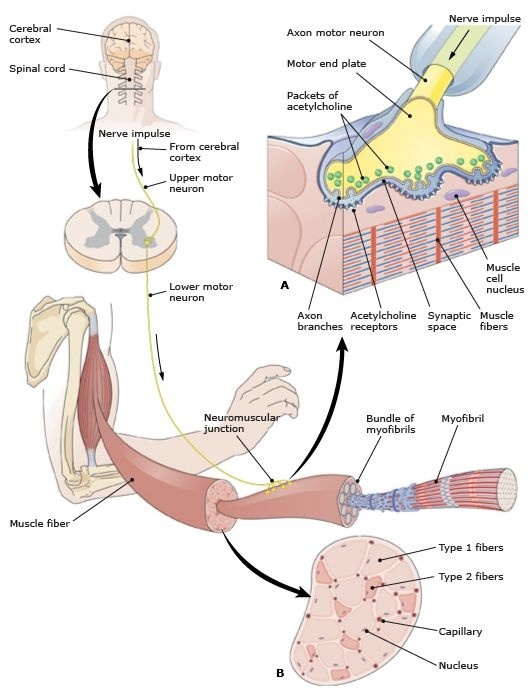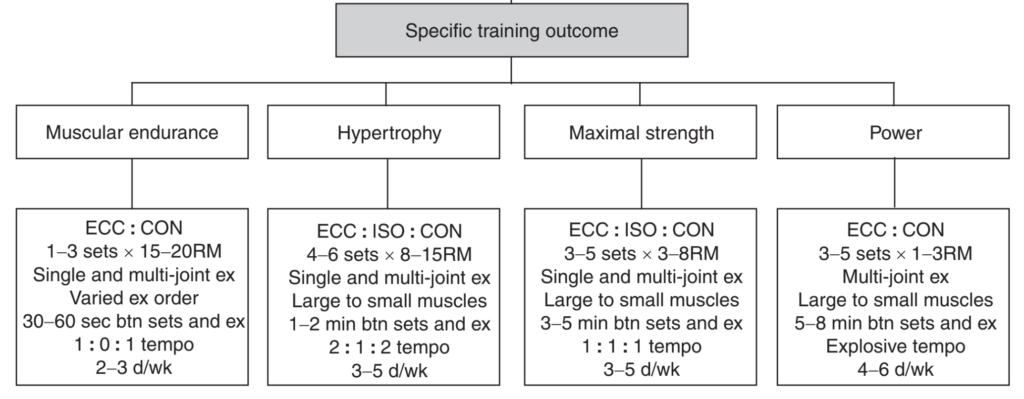This is part 3 of our 3 part series on ‘What’s The Point of Training?’.
In part 1 we learnt about motor control and how to apply this to training.
In part 2 we learnt some training terminology and started exploring the specifics of training the different parameters of motor control .
Today we’ll dive a little deeper and give specific examples of how to apply the information into your personal training and movement planning.
Motor Control Recap
The Motor Control Concept
Motor Control is considered “the process of initiating, directing, and grading purposeful voluntary movement”.
Picture 1. Schematic diagram of neuromuscular motor function

Picture breakdown:
A thought to move becomes a mobile electrical impulse.
This nerve impulse relays from the brain to the muscle via motor neurons.
A cascade of events occurs when the nerve impulse meets the muscle, leading to a muscle contraction.
Training Specific Recap
Picture 2. Program design for specific parameter outcomes.

RM = rep maximum. Min = minute/s. btn = between. Ex = exercise. d/wk = days per week
.
How to Apply This Information
If you have plateaued in performance or are considering taking your bouldering to another level with the assistance of resistance training you’ll need to spend time identifying where you need the most work.
Do you find that you are having issues with:
Strength
Pull yourself up from an extended arm?
Push through the legs when your knee is higher than your hips?
Power
Move quickly through a sequence in the problem?
Dyno?
Endurance
Forearm muscles fatigue earlier in the climb than you’d like?
Strength / Endurance / Coordination
Keep the hips close to the wall?
Keep the chest close to the wall?
If any of these questions relate to your bouldering, read on for training ideas and examples.
Prepare Your Body
As a physio, over 90% of tendinopathy cases coming in are related to a recent increase in training load.
If you are currently not training a great deal and you plan on starting, start low and go slow. Meaning, start your training plan doing less than you think you can do, see how the body responds and either reduce, maintain or increase the training load accordingly on a day-to-day or week-to week basis.
Know that you will have good and bad days in training (due to sleep, diet, stress, recovery, etc,). Try to notice the tough days and be kinder to yourself those days.
For example, last week you completed 10 rounds of 5 pull-ups; but today 5 pull-ups feels like 40 and it hurts. Drop to 3 pull-ups with great focus and technique and you’ll get far more benefits than grinding and fighting through 5.
Until recently I never listened to the above advice I’m giving, so I won’t hold it against you if you go out guns blazing, but you have been warned.
I’ll finish with one last thought to take into your training,
Listen to your body when it whispers, so you don’t have to hear it scream.
Programming Examples & Ideas
Pull-up strength day
Example workout:
Warm-up – 15-30sec between movements:
1-2 sets
A1 – 10 x banded or broomstick dislocates
A2 – 10 x hanging reverse shrugs
A3 – 10 x hanging internal & external rotations
Strength component
3-5 sets. 60-120sec rest between sets.
B1 – 3-8 x Pull ups
*Increase resistance by adding weight to the body.
*Decrease resistance by doing band-assisted pull ups OR doing eccentric-only
Endurance component
3 sets. 0-minimal rest between sets.
C1 – 12 x Ring rows
C2 – 20 x Kettlebell swings
OR (if you like to mix up your pull with some push)
C1 – 12 x Ring rows
C2 – 12 x DB push press
Cool Down
1-2 sets. 90-120sec rest between sets.
D1 – 1 x 75% maximum of passive hang (grip firmly to reduce ‘elbow strain’/forearm flexor and extensor strain)
How to tailor this day to power?
Change the strength component to a power component by reducing the rep numbers to 3 and making the pull/concentric phase more explosive.
How to tailor this day to hypertrophy (aka muscle growth)?
Change the strength component to a hypertrophy component by increasing the rep numbers to 8+.
How to tailor this day to endurance?
Change the strength component to an endurance component by increasing the rep numbers to 12+ and reduce the rest to 45-90sec.
Single leg squat strength day
Example workout:
Warm-up – 15-30sec between movements:
2 sets
A1 – 5 x 90:90 transitions
A2 – 30-60sec bottom of squat discovery
A3 – 10 x air squats
Strength component
3-5 sets. 60-120sec rest between.
B1 – 5-8 x Box step-ups
*Increase/decrease resistance through box height +/- the addition of weight.
B2 – 5-8 x Hip thrusts
*Increase/decrease resistance and complexity through reduction of limbs. Ie.
Easiest to Hardest – 2 arms and 2 legs on the ground > 2 arms, 1 leg > 1 arm, 1 leg – contralateral.
Endurance component
4 sets. 1 minute rest between sets.
C1 – 12 x deadlifts
C2 – 30 x walking unilateral DB OH lunges (15/leg) +/- weight as needed
C3 – 100 x single skips or 50 x double under skips
Cool-down – 15-30sec between movements:
1 set
A1 – 5 x 90:90 transitions
A2 – 30-60sec bottom of squat discovery
How to tailor this day to power?
Change the strength component to a power component by reducing the rep numbers to 3-5 and weight, and making the step-up/concentric phase more explosive, OR, changing the step-ups to broad jumps.
How to tailor this day to hypertrophy (aka muscle growth)?
Change the strength component to a hypertrophy component by increasing the rep numbers to 8+.
How to tailor this day to endurance?
Change the strength component to an endurance component by increasing the rep numbers to 12+ and reduce rest to 45-90sec.
*Note: These are very big days for a beginner. Beginners should omit the endurance component for the first 2-6 weeks of training to give their muscles and tendons time to adapt to the new training loads placed on them.
Unprepared tendons get angry when not given time to prepare and recover.
We sincerely hope you have found a few takeaways from this training series.
If there is anything you were hoping we would cover more specifically or if there is something you’d like us to breakdown further please let us know in the comments section of our instagram page or email us directly at hello@bouldmove.com.au.
Sign up here for all of the latest Bould Move news.
We can not wait to move, train and climb with you at Bould Move Sunshine Coast.
